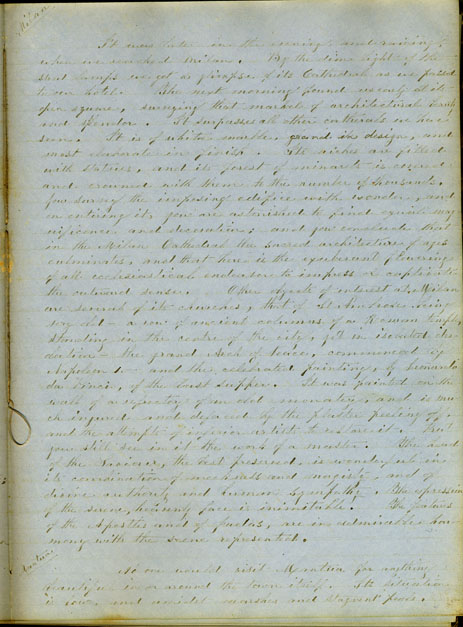Travel
Diary of Mrs. R.P. Eaton:
Europe,
Egypt, and Palestine, ca. 1857

It was late in the evening, and raining, when we reached Milan. By the dim light of the street lamps we got a glimpse of the Cathedral as we passed to our hotel. The next morning found us early at its open square, surveying that marvel of architectural beauty and splendor. It surpasses all other cathedrals we have seen. It is of white marble, grand in design, and most elaborate in finish. Its niches are filled with statues, and its forest of minarets is covered and crowned with them to the number of thousands. You survey the imposing edifice with wonder, and on entering it, you are astonished to find equal magnificence and decoration; and you conclude that in the Milan Cathedral the sacred architecture of ages culminates, and that here is the exuberant flowering of all ecclesiastical endeavor to impress or captivate the outward sense. Other objects of interest at Milan are several of its churches, that of St. Ambrose being very old – a row of ancient columns of a Roman temple, standing in the centre of the city, yet in isolated desolation – the grand Arch of Peace, commenced by Napoleon I – and the celebrated painting, by Leonardo da Vinci, of the Last Supper. It was painted on the wall of a refectory of an old monastery, and is much injured and defaced by the plaster peeling off, and the attempts of inferior artists to restore it. But you still see in it the work of a master. The head of the Savior, the best preserved, is wonderful in combination of meekness and majesty, and of divine authority and human sympathy. The expression of the serene, heavenly face is inimitable! The features of the Apostles and of Judas, are in admirable harmony with the scene represented.
(Mantua)
No one would visit Mantua for anything beautiful in or around the town
itself. Its situation is love and amidst marshes stagnant pools.